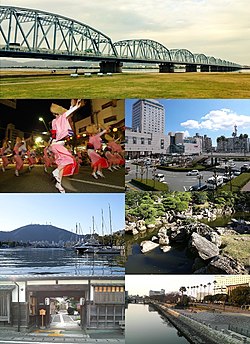Tokushima (徳島市, Tokushima-shi, Japanese: [tokɯ̥ꜜɕima]) is the capital city of Tokushima Prefecture on Shikoku island in Japan. As of 1 September 2024[update], the city had an estimated population of 245,264 in 122,539 households and a population density of 1,280 persons per km².[1] The total area of the city is 191.52 square kilometres (73.95 sq mi).
Tokushima
徳島市 | |
|---|---|
 Left to right from top: Yoshinogawa Bridge, Awa Odori in August, Tokushima Station, Mount Bizan, Senshukaku Garden at Tokushima Castle, Awa Jūrōbei House, Aibahama Park | |
 Location of Tokushima in Tokushima Prefecture | |
 | |
| Coordinates: 34°4′N 134°33′E / 34.067°N 134.550°E | |
| Country | |
| Region | Shikoku |
| Prefecture | |
| City Status | October 1, 1889 |
| Government | |
| • Mayor | Akiyoshi Endō |
| Area | |
| • Total | 191.52 km2 (73.95 sq mi) |
| Population (September 1, 2024) | |
| • Total | 245,264 |
| • Density | 1,280/km2 (3,300/sq mi) |
| Time zone | UTC+9 (JST) |
| Symbols | |
| • Tree | Elaeocarpus sylvestris |
| • Flower | Prunus serrulata |
| Phone number | 088-621-5111 |
| Address | 2-5 Saiwaichō, Tokushima-shi, Tokushima-ken 770-8571 |
| Website | Official website |
Geography
editThe city is situated in the north-eastern part of Tokushima Prefecture at the mouth of the Yoshino River. In terms of layout and organization, Tokushima displays the typical characteristics of a Japanese castle town. Most of the city is located in the Tokushima plain and is flat, but the symbol of the city, Mt. Bizan, rises in the center, creating a scenic landscape. The southern part is a mountainous area with forests.
Mountains
edit| Name | Height | Notes |
|---|---|---|
| Bizan (眉山) |
277 m | |
| Shiroyama (城山) |
62 m | |
| Nakatsu Mineyama (中津峰山) |
773 m | The highest mountain in the Tokushima City district. |
| Nishi Ryuo-san (西竜王山) |
495 m | |
| Higashi Ryuo-san (東龍王山) |
408m | |
| Kinobeyama (気延山) |
212 m | |
| Bentenyama (弁天山) |
6.1 m | Claimed to be the smallest natural mountain in Japan. |
Rivers
editNeighbouring municipalities
editTokushima Prefecture
Demographics
editPer Japanese census data,[2] the population of Tokushima has been growing steadily for the past century.
| Year | Pop. | ±% |
|---|---|---|
| 1920 | 140,534 | — |
| 1930 | 158,688 | +12.9% |
| 1940 | 164,572 | +3.7% |
| 1950 | 177,363 | +7.8% |
| 1960 | 203,326 | +14.6% |
| 1970 | 223,451 | +9.9% |
| 1980 | 249,343 | +11.6% |
| 1990 | 263,356 | +5.6% |
| 2000 | 268,218 | +1.8% |
| 2010 | 264,764 | −1.3% |
Climate
editTokushima has a humid subtropical climate (Köppen climate classification Cfa) with hot summers and cool winters. Precipitation is high, but there is a pronounced difference between the wetter summers and drier winters.
| Climate data for Tokushima (1991−2020 normals, extremes 1891−present) | |||||||||||||
|---|---|---|---|---|---|---|---|---|---|---|---|---|---|
| Month | Jan | Feb | Mar | Apr | May | Jun | Jul | Aug | Sep | Oct | Nov | Dec | Year |
| Record high °C (°F) | 22.5 (72.5) |
23.2 (73.8) |
26.4 (79.5) |
30.1 (86.2) |
32.9 (91.2) |
35.7 (96.3) |
38.4 (101.1) |
38.2 (100.8) |
36.2 (97.2) |
33.4 (92.1) |
27.1 (80.8) |
26.7 (80.1) |
38.4 (101.1) |
| Mean daily maximum °C (°F) | 10.0 (50.0) |
10.8 (51.4) |
14.3 (57.7) |
19.6 (67.3) |
24.0 (75.2) |
26.8 (80.2) |
30.6 (87.1) |
32.3 (90.1) |
28.5 (83.3) |
23.1 (73.6) |
17.7 (63.9) |
12.5 (54.5) |
20.9 (69.6) |
| Daily mean °C (°F) | 6.3 (43.3) |
6.8 (44.2) |
9.9 (49.8) |
15.0 (59.0) |
19.6 (67.3) |
23.0 (73.4) |
26.8 (80.2) |
28.1 (82.6) |
24.8 (76.6) |
19.3 (66.7) |
13.8 (56.8) |
8.7 (47.7) |
16.8 (62.2) |
| Mean daily minimum °C (°F) | 2.9 (37.2) |
3.1 (37.6) |
5.8 (42.4) |
10.6 (51.1) |
15.6 (60.1) |
19.8 (67.6) |
23.9 (75.0) |
24.9 (76.8) |
21.6 (70.9) |
15.9 (60.6) |
10.1 (50.2) |
5.2 (41.4) |
13.3 (55.9) |
| Record low °C (°F) | −5.4 (22.3) |
−6.0 (21.2) |
−3.6 (25.5) |
−0.7 (30.7) |
4.6 (40.3) |
9.7 (49.5) |
15.3 (59.5) |
16.6 (61.9) |
11.9 (53.4) |
4.5 (40.1) |
−1.3 (29.7) |
−4.3 (24.3) |
−6.0 (21.2) |
| Average precipitation mm (inches) | 41.9 (1.65) |
53.0 (2.09) |
87.8 (3.46) |
104.3 (4.11) |
146.6 (5.77) |
192.6 (7.58) |
177.0 (6.97) |
193.0 (7.60) |
271.2 (10.68) |
199.5 (7.85) |
89.2 (3.51) |
63.9 (2.52) |
1,619.9 (63.78) |
| Average snowfall cm (inches) | 1 (0.4) |
1 (0.4) |
0 (0) |
0 (0) |
0 (0) |
0 (0) |
0 (0) |
0 (0) |
0 (0) |
0 (0) |
0 (0) |
0 (0) |
2 (0.8) |
| Average precipitation days (≥ 0.5 mm) | 6.5 | 7.1 | 10.3 | 10.1 | 9.7 | 13.2 | 11.2 | 9.0 | 11.4 | 9.4 | 7.7 | 6.5 | 112.2 |
| Average relative humidity (%) | 61 | 61 | 61 | 62 | 67 | 75 | 77 | 73 | 72 | 69 | 66 | 63 | 67 |
| Mean monthly sunshine hours | 160.3 | 152.5 | 179.8 | 197.9 | 205.7 | 151.9 | 192.0 | 230.6 | 162.0 | 163.6 | 150.4 | 160.1 | 2,106.8 |
| Source: Japan Meteorological Agency[3] | |||||||||||||
History
editAs with all of Tokushima Prefecture, the area of Tokushima was part of ancient Awa Province. Tokushima was developed around Tokushima Castle, the seat of the Hachisuka clan, daimyo of Tokushima Domain under the Edo Period Tokugawa shogunate. Its prosperity was built on a strong indigo dye industry. Following the Meiji restoration, the city of Tokushima was established on October 1, 1889 with the creation of the modern municipalities system. At the time, it was the 10th largest city in Japan.
World War II air raid
editTokushima was selected as a target by the United States' XXI Bomber Command during World War II because of the city's role as an agricultural center for the region. On July 3, 1945, at 5:45 PM (JST) 137 aircraft took off to bomb Tokushima. 1,050 tons of incendiary bombs were dropped on Tokushima, destroying 74% of the built up areas of the city.[4] Over 1000 people were killed in the bombing (431 men, 553 women, 17 of unknown gender) and over 2000 people were injured. The number of incendiary bombs dropped on Tokushima City was enormous at 354,664, and since the population of Tokushima City was 115,508 in 1944, it is calculated that 3.07 incendiary bombs were dropped per citizen.
Government
editTokushima has a mayor-council form of government with a directly elected mayor and a unicameral city council of 30 members. Tokushima contributes ten members to the Tokushima Prefectural Assembly. In terms of national politics, the city is part of Tokushima 1st district of the lower house of the Diet of Japan.
Economy
editTokushima has been the economic center of eastern Shikoku since the Edo period, when prospered as a distribution center for indigo and timber, and was one of the leading commercial cities in Japan. It has a deep connection with the Kansai region especially Osaka, which has become even more prominent in modern times after the opening of the Akashi Kaikyo Bridge. Following the decline of the indigo industry, the accumulated wealth of the merchant class led to the development of banks and financial institutions, which in turn led to modern industries such as spinning, papermaking, pharmaceuticals, food processing and electric power. Although the city area was burnt to the ground due to the Tokushima air raid in World War II, it was quickly reconstructed. There are numerous industrial parks.
Agriculture and forestry both remain as major contributors the local economy. The Tokushima Plain in the Yoshino and Katsuura river basins have fertile agricultural land, and in addition to rice, some items such as cauliflower and carrots are major local products.
Education
editUniversities and colleges
editPrimary and secondary education
editTokushima has 30 public elementary schools and 18 public middle schools operated by the city government and nine public high schools operated by the Tokushima Prefectural Department of Education. There are also one private elementary school, three private middle schools and five private high schools. The prefecture also operates one night school and four special education schools for the disabled.
Transportation
editAirport
edit- Tokushima Airport, which is located in neighboring town of Matsushige
Railway
editShikoku Railway Company – Kōtoku Line
Shikoku Railway Company – Mugi Line
- Tokushima - Awa-Tomida - Niken'ya - Bunkanomori - Jizōbashi
Shikoku Railway Company – Tokushima Line
Highways
editSister cities
editLocal attractions
edit- Awa Kokubun-ji, 15th temple on the Shikoku Pilgrimage
- Dainichi-ji, 13th temple on the Shikoku Pilgrimage
- Ichinomiya Jinja, one of the ichinomiya of former Awa Province
- Ido-ji, 17th temple on the Shikoku Pilgrimage
- Jōraku-ji, 14th temple on the Shikoku Pilgrimage
- Kan'on-ji, 16th temple on the Shikoku Pilgrimage
- Shibunomaruyama Kofun, National Historic Site
- Tokushima Archaeological Museum
- Tokushima Castle
- Tokushima Castle Museum
- Tokushima Domain Hachisuka clan cemetery, National Historic Site
- Tokushima Prefectural Museum
Culture
editEvery August, during the Obon Festival, Tokushima holds a cultural dance festival, the Awa Odori. Awa Odori literally translates as "Awa Dance" (Awa being Tokushima Prefecture's ancient name). During the festival, residents ranging from young children to professional dance troupes perform a distinctive style of Japanese traditional dance in regional costumes, accompanied by strings, drums, and singing (usually by the dancers themselves).
Sports
editThe city's Asty Tokushima arena hosted the official 2007 Asian Basketball Championship.
Gallery
edit-
Tokushima Station Bus Terminal
-
Awa Dancing Festival, well-known Bon Festival
-
statue of Hachisuka Iemasa
References
editExternal links
edit- Tokushima City official website (in Japanese)
- Tokushima City official website (in English)
- Tokushima travel guide from Wikivoyage
- Geographic data related to Tokushima (city) at OpenStreetMap

